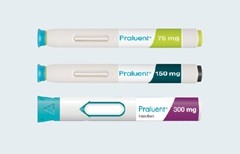Praluent is a medicine that lowers levels of “bad” cholesterol. It works by helping to remove bad cholesterol from the blood. High levels of bad cholesterol can lead to health problems like heart disease (including heart attacks) and strokes. It may be used with other medicines that lower your levels of cholesterol.
Even if you don’t feel any different, Praluent will be working to lower your levels of bad cholesterol. It is important to keep using Praluent as prescribed by your doctor even if you feel well.
Praluent is given as an injection just under the skin, by a pen already filled with the medicine, usually every two or four weeks depending on the dose.
Praluent contains a medicine called alirocumab. It also contains small amounts of histidine, sucrose and polysorbate 20 as well as water, to help keep the medicine stable.
If you are already taking statins, you will probably need to keep taking them as well as Praluent, as this is a good way of helping to lower your levels of high cholesterol. Your doctor will tell you what other medicines you may need to take along with Praluent.
- You may have already tried other medicines, such as statins, to help lower your levels of cholesterol.
- In many people with coronary heart disease, statins on their own may not be enough to get cholesterol down to healthy levels.1
- Some people are not able to take statins because of side-effects.2
Before injecting Praluent, please read carefully your injection guide and the package leaflet provided in the box containing your Praluent pen. You can watch the video on how to inject Praluent here.
- Every Praluent pen dispensed to you is filled with the right amount of Praluent
- You should inject all of it
- Praluent is available in three doses - 75mg, 150mg and 300mg
- Your dose will be decided by your doctor.
- For 75mg and 150mg strengths
Praluent is usually prescribed as an injection once every two weeks. For these doses, If you inject Praluent on a Monday for example, the next time you inject it will be two weeks later, also on a Monday. - For 300mg strength
Praluent is usually prescribed as an injection once every four weeks (monthly). For this dose, Praluent should be injected the same day every month, for example, the 1st of the month.
Skin can sometimes become red, swollen, or itchy after injecting Praluent. If it stays like this or gets worse, stop using Praluent and contact your doctor.
Before injecting Praluent, make yourself as comfortable and relaxed as possible. In addition to your Praluent pen, you will need:
- Alcohol wipes
- Cotton wool balls or gauze
- A yellow needle bin (also called a sharps bin) to get rid of used pens. Your doctor or nurse will provide you with a sharps bin.
- If you forget to inject a dose, inject Praluent as soon as possible. You should then inject your next Praluent dose as normal.
- For 75mg and 150mg strengths
For example, if you normally inject Praluent every two weeks on a Monday and forget to inject it that day, inject it the next day (Tuesday) but go back to injecting it on a Monday two weeks later. - For 300mg strength
In case you normally inject Praluent every four weeks (monthly) on the 1st of the month and forget to inject it that day, inject it the next day (2nd) but go back to injecting it on the 1st of the next month.
Each Praluent pen is pre-filled to ensure each dose is the right amount.
You can inject Praluent into your:

- Do not inject Praluent on tender, inflamed, infected, hard or hot skin, including on sunburnt skin and rashes
- Do not inject Praluent near a visible vein
- Do not inject Praluent through your clothes
When injecting Praluent, you might experience a brief period of pain or discomfort.
If the pen is damaged or not working properly in any way, do not use it or try to fix it. Please contact your doctor for a replacement pen and call the Sanofi Medical Information Department straight away on 0800 035 2525.
While you are a patient prescribed with Praluent, your doctor will continue to check your cholesterol levels. These tests will help your doctor know whether Praluent is working well for you.
Once you begin using Praluent, your doctor will monitor your cholesterol levels. If Praluent is reducing your cholesterol levels enough, you may be able to keep taking the same dose. Your doctor may talk to you about increasing your dose if your cholesterol levels are not going down enough.
Having a high cholesterol level is a life-long condition and Praluent is likely to be used long-term. Keeping your cholesterol level down is important for your overall health. If you stop injecting Praluent, it is likely that your cholesterol will return to its previous high level. Your doctor will be able to advise whether you need to keep injecting Praluent, and you should not stop taking your medicine without seeking your doctor’s advice.
Praluent is not recommended if you are pregnant or breast-feeding. In these cases, please ask your doctor for advice before using Praluent.
Praluent must be used within 30 days of being removed from your refrigerator, and always stored below 25°C and protected from light. When you travel and need to take Praluent with you, use a cool bag to keep your pen cool and out of light. Never freeze your Praluent pen.
- Keep Praluent in the fridge (do not freeze it)
- Store in the original box to protect it from light
- Praluent Pen 75/150mg: 30 to 40 minutes before injection, take your Praluent pen out of the fridge. Use it as soon as possible once 30 to 40 minutes have passed.
Praluent Pen 300mg: 45 minutes before injection, take your Praluent pen out of the fridge. Use it as soon as possible once 45 minutes have passed. - Look at the medication liquid through the window on the side of the pen. The colour should be clear to pale yellow
- Do not use if the liquid is any other colour or contains bits in it
- Do not heat the pen
To make it easier to use, and to make your injection feel more comfortable. The time required before injection is 30 to 40 minutes for Praluent 75/150mg pen and 45 minutes for Praluent 300mg pen.
Do not use any Praluent if it has:
- been left out of the fridge for more than 30 days
- reached a temperature higher than 25°C
OR
Once you have used the pen, throw it away in the sharps bin provided by your doctor. Do not re-use the pen.
Arrangements are different depending on where you live. Your doctor will be able to give you information on what happens in your area.
Like all medicines, Praluent can have unwanted effects known as side-effects. Common side-effects happen most often in the place where you inject, and can include swelling, pain and itchy skin. Some people also get cold-like symptoms e.g. sore throat, runny nose and sneezing. Please look at the Praluent package leaflet for full information on side effects, and speak with your doctor if you are worried.
If you get any side effects, talk to your doctor, pharmacist or nurse. This includes any possible side effects not listed in the package leaflet. You can also report side effects directly via the Yellow Card Scheme at https://yellowcard.mhra.gov.uk/.
You should not use Praluent if you are allergic to alirocumab or anything else found in Praluent (histidine, sucrose or polysorbate 20). Praluent is not recommended during pregnancy or breast-feeding.
References
- Jones P.H, Nair R, & Thakker K.M, Prevalence of dyslipidemia and lipid goal attainment in statin-treated subjects from 3 data sources: a retrospective analysis. J Am Heart Assoc 2012;1(6):e001800.
- Arca M. & Pigna G, Treating statin-intolerant patients. Diabetes Metab Syndr Obes 2011;4:155–66.
Previous
Your Praluent penNext
Glossary




